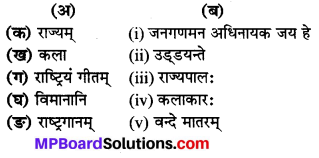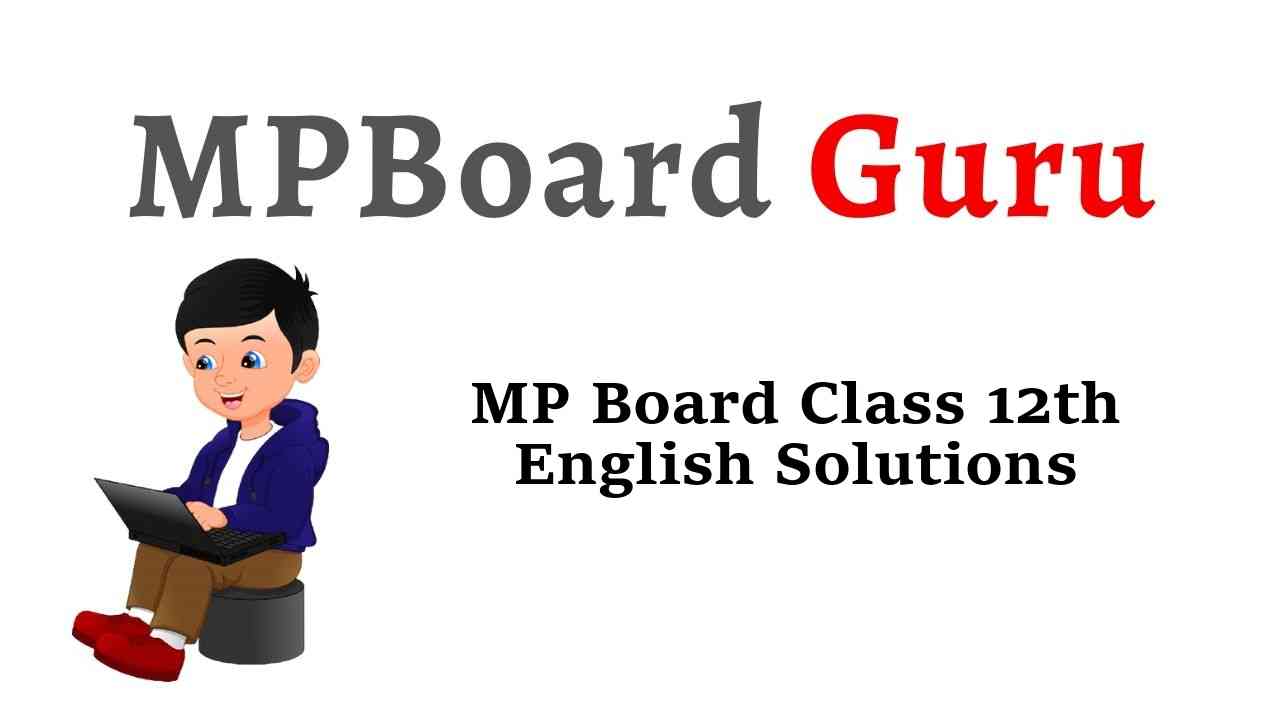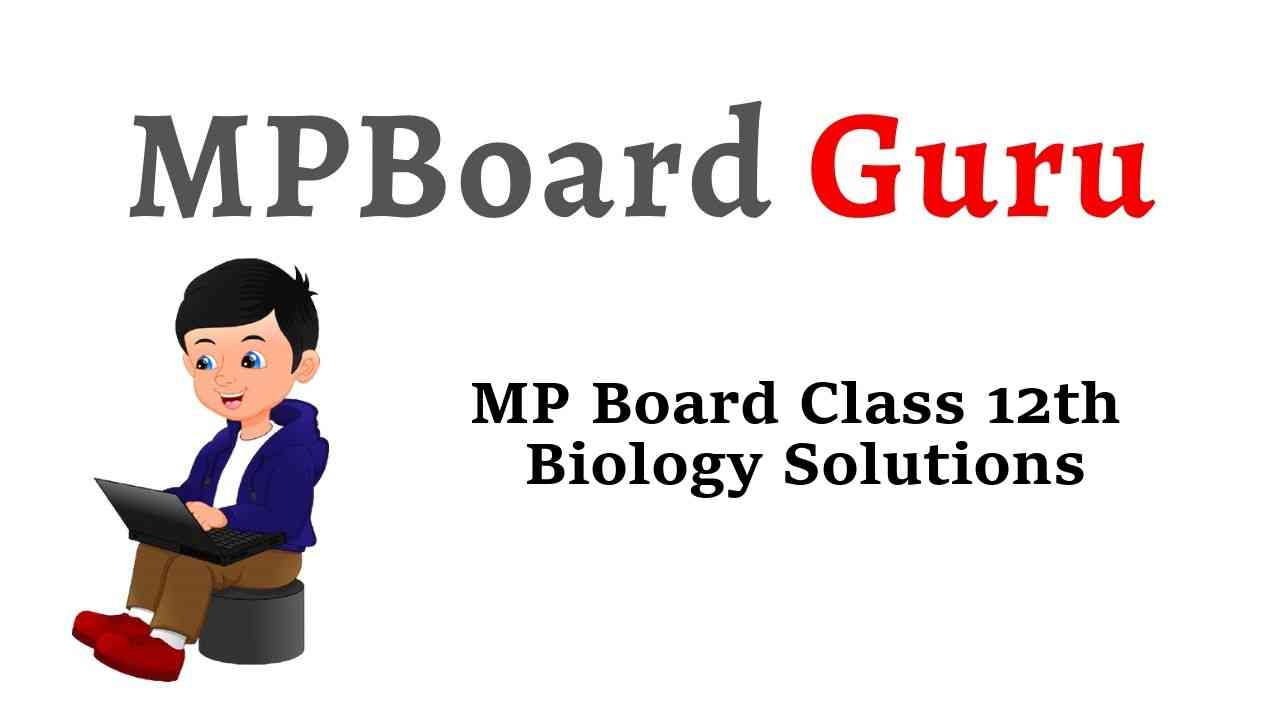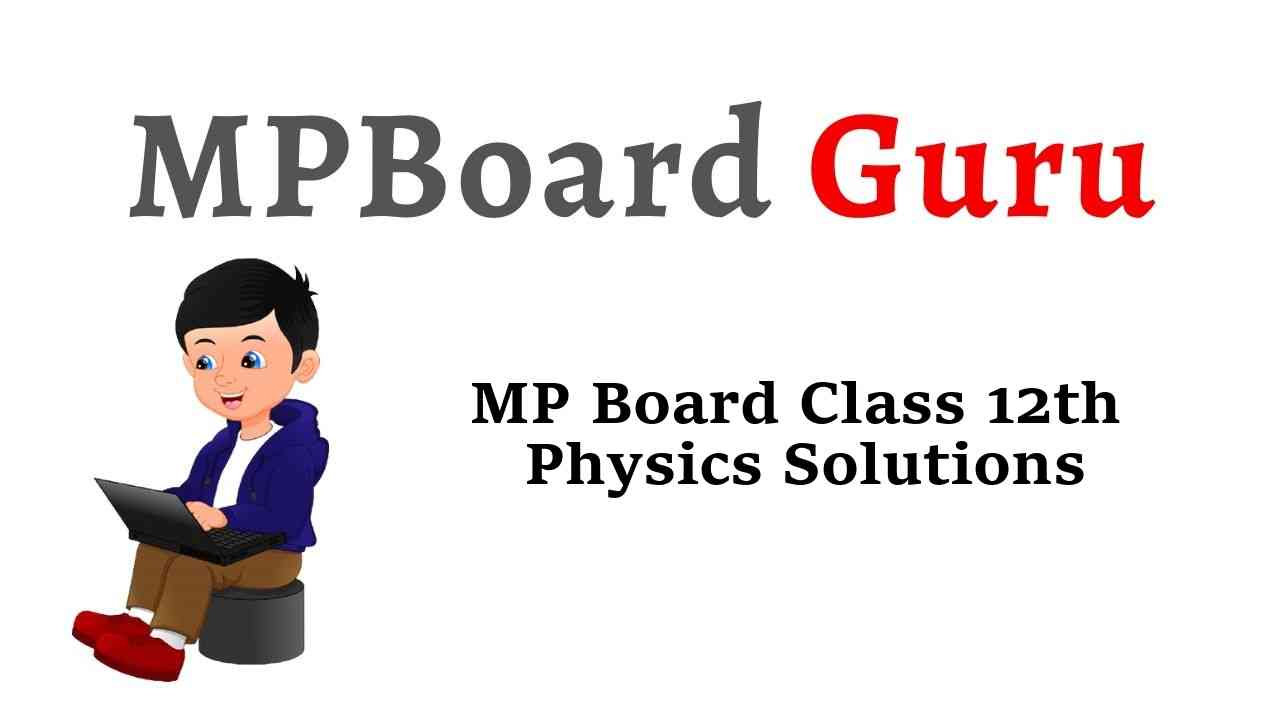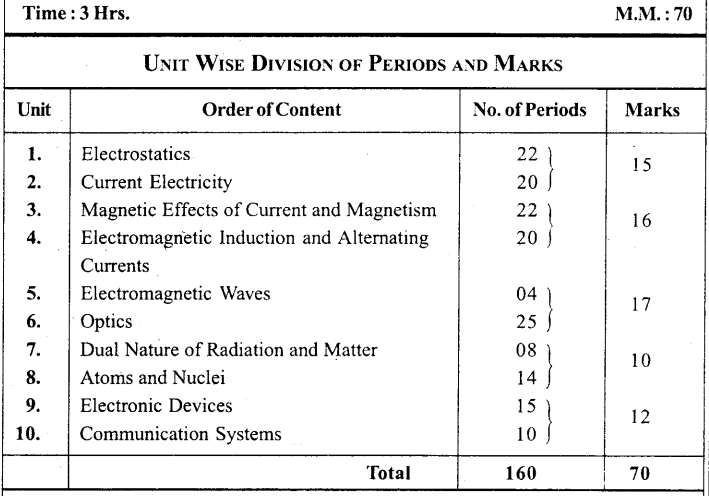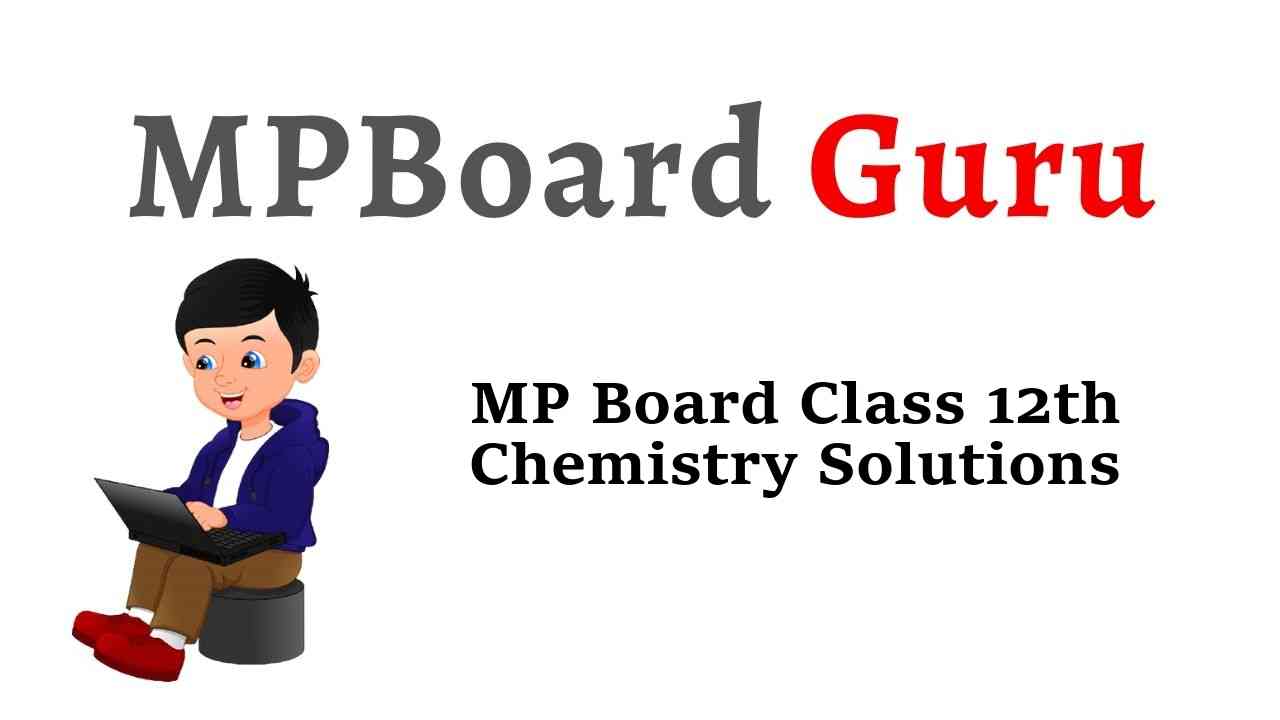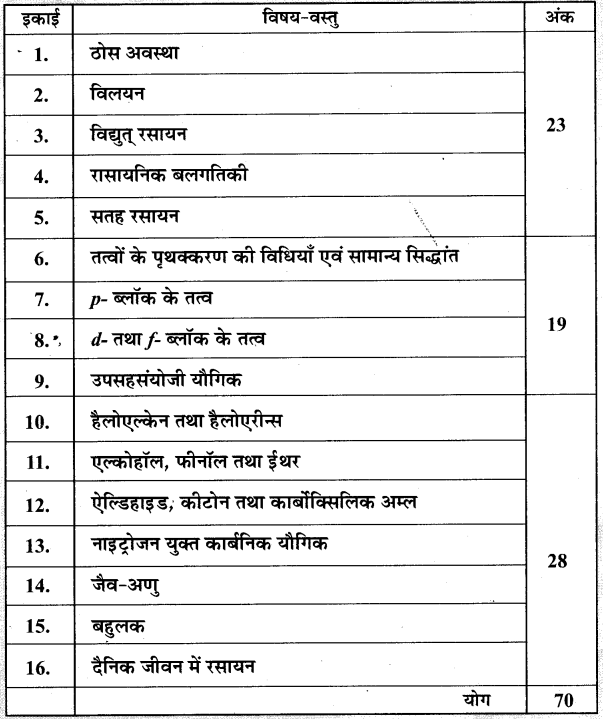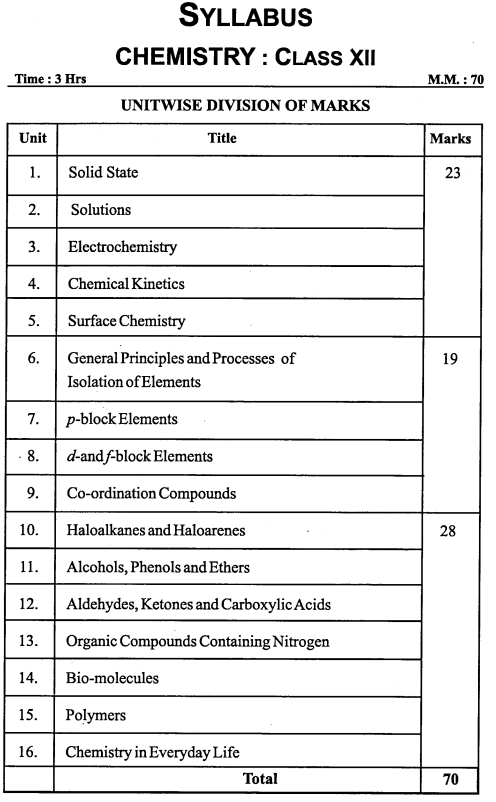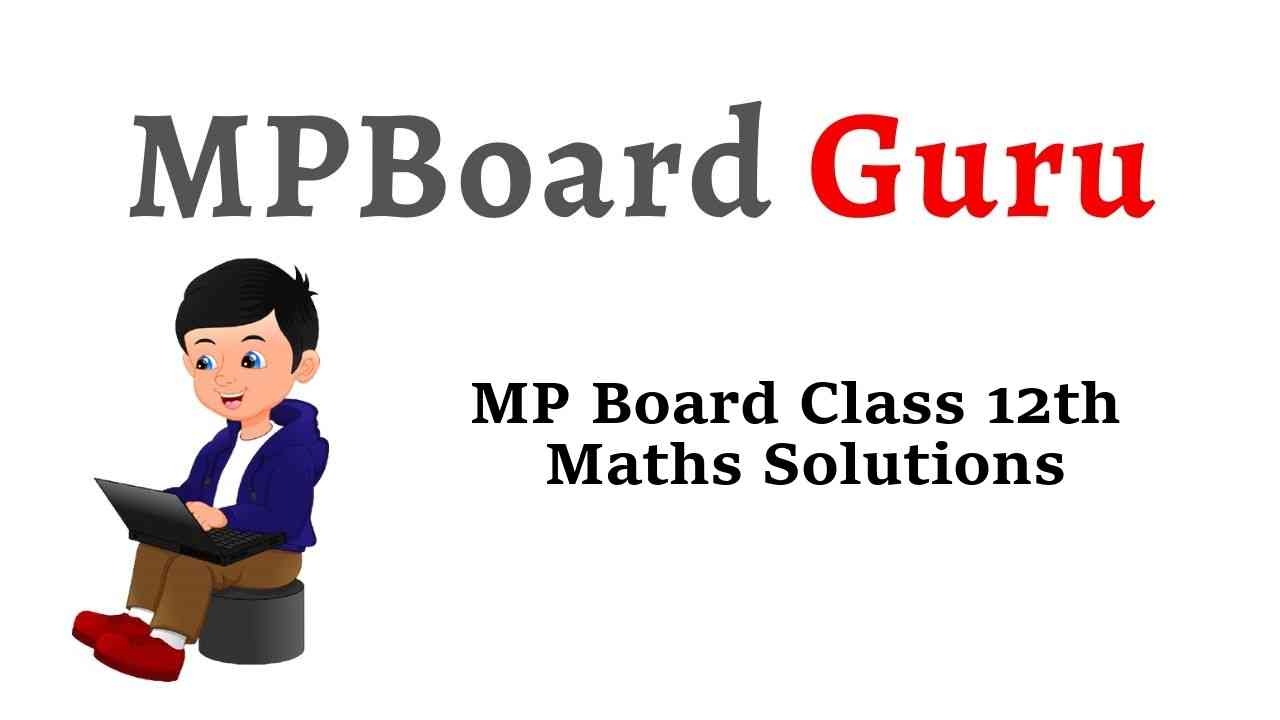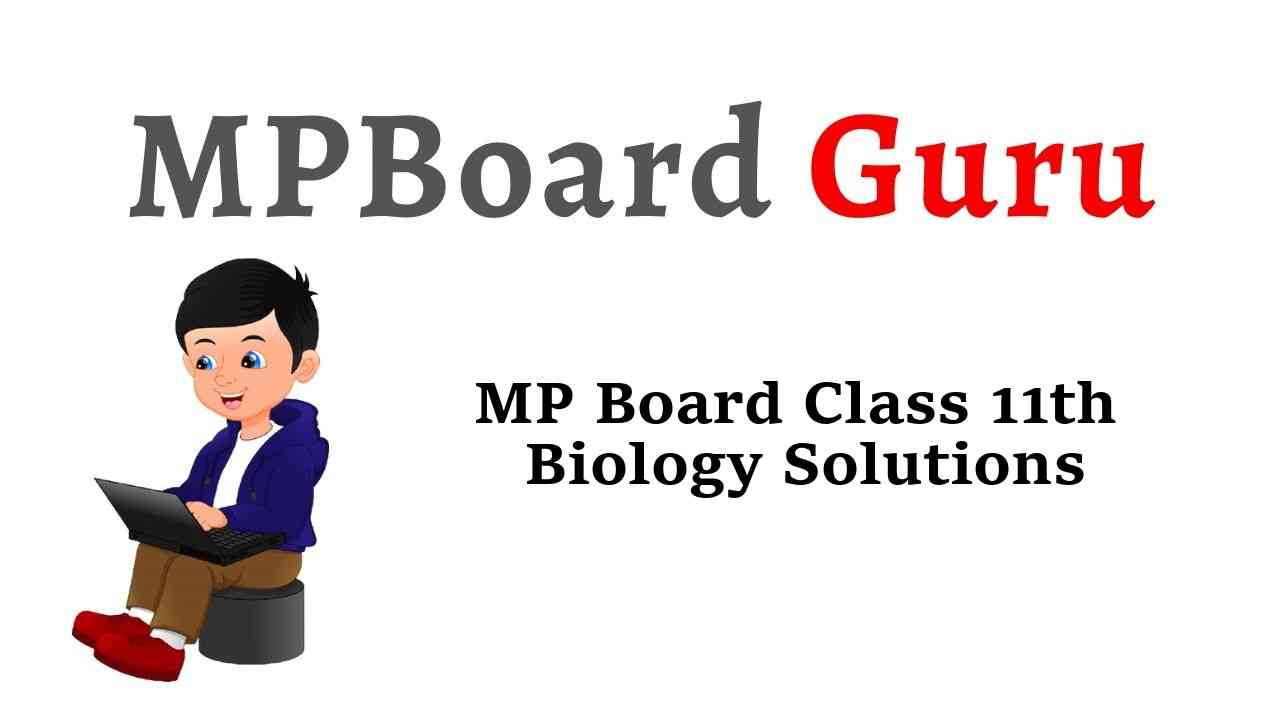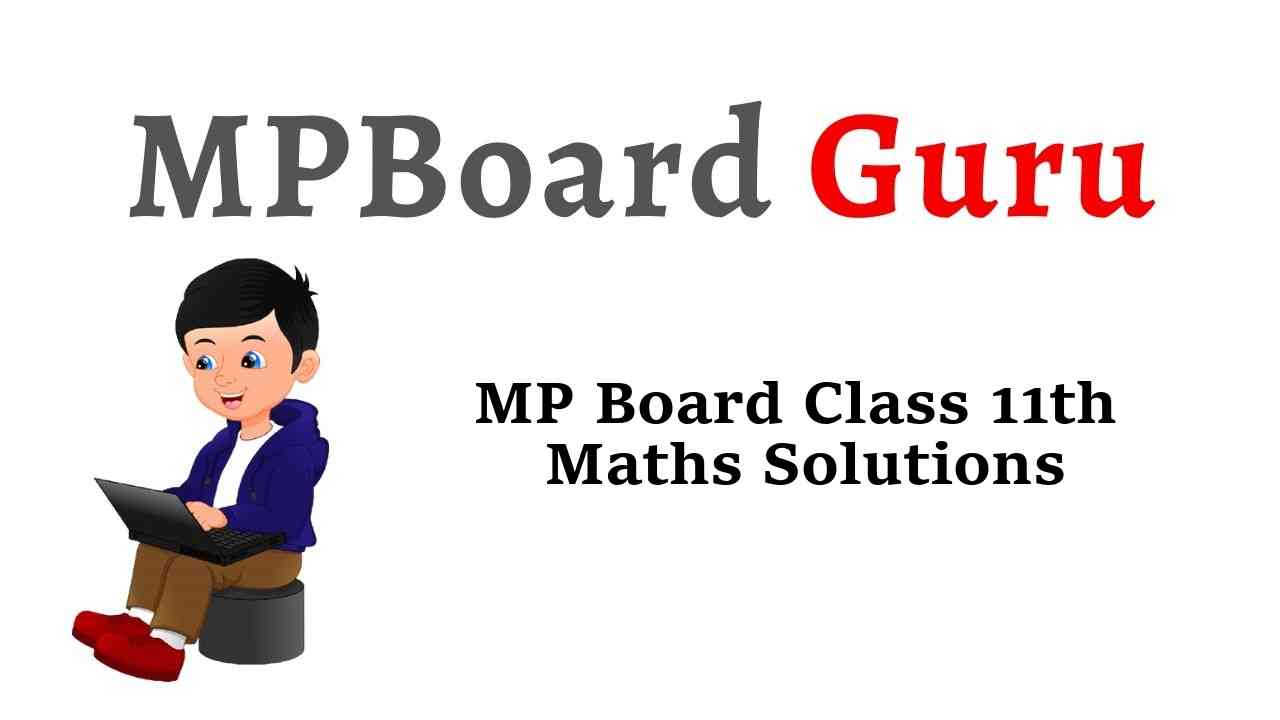MP Board Class 8th Sanskrit Solutions Surbhi Chapter 10 आजादचन्द्रशेखरः
MP Board Class 8th Sanskrit Chapter 10 अभ्यासः
Mp Board Class 8 Sanskrit Chapter 10 प्रश्न 1.
एकपदेन उत्तरं लिखत (एक शब्द में उत्तर लिखो-)
(क) चन्द्रशेखरस्य जन्म कस्मिन् ग्रामे अभवत्? (चन्द्रशेखर का जन्म किस गाँव में हुआ था?)
उत्तर:
भाभराग्रामे। (भाभरा गाँव में)
(ख) चन्द्रशेखरस्य जन्म कस्मिन् मण्डले अभवत्? (चन्द्रशेखर का जन्म किस मण्डल में हुआ?)
उत्तर:
झाबुआमण्डले। (झाबुआ मण्डल में)
(ग) चन्द्रशेखरस्य मातुः नाम किम्? (चन्द्रशेखर की माता का नाम क्या था?)
उत्तर:
जगरानी देवी। (जगरानी देवी)
(घ) चन्द्रशेखरस्य पितुः नाम किम्? (चन्द्रशेखर के पिता का नाम क्या था?)
उत्तर:
सीताराम तिवारी। (सीताराम तिवारी)
(ङ) चन्द्रशेखरः काम् भाषाम् अधीतवान्? (चन्द्रशेखर ने किस भाषा को पढ़ा?)
उत्तर:
संस्कृतभाषाम्। (संस्कृत भाषा को)
Mp Board Class 8 Sanskrit Solution Chapter 10 प्रश्न 2.
एकवाक्येन उत्तरं लिखत (एक वाक्य में उत्तर लिखो-)
(क) चन्द्रशेखरस्य जन्म कदा अभवत्? (चन्द्रशेखर का जन्म कब हुआ?)
उत्तर:
चन्द्रशेखरस्य जन्म १९०६ ख्रिस्ताब्दे अभवत्। (चन्द्रशेखर का जन्म 1906 ईस्वी में हुआ।)
(ख) चन्द्रशेखरस्य अध्ययनं कुत्र जातम्? (चन्द्रशेखर का अध्ययन कहाँ हुआ?)
उत्तर:
चन्द्रशेखरस्य अध्ययनं वाराणस्याम् एकस्मिन् संस्कृतविद्यालये जातम्। (चन्द्रशेखर का अध्ययन वाराणसी में एक संस्कृत विद्यालय में हुआ।)
(ग) चन्द्रशेखरेण केन नाम्ना सङ्गठनं कृतम्? (चन्द्रशेखर ने किस नाम से संगठन किया?)
उत्तर:
चन्द्रशेखरेण ‘हिन्दुस्तान सोसलिस्ट रिपब्लिकन आर्मी’ इति नाम्ना संगठनं कृतम्। (चन्द्रशेखर ने ‘हिन्दुस्तान सोसलिस्ट रिपब्लिकन आर्मी’ नाम से संगठन किया।)
(घ) स्वाधीनतान्दोलने के के चन्द्रशेखरस्यसहायकाः अभवन्? (स्वाधीनता के आन्दोलन में कौन-कौन चन्द्रशेखर के सहायक हुए?)
उत्तर:
स्वाधीनतान्दोलने भगतसिंह-राजगुरु-बटुकेश्वर शिवराम-सुखदेवसदृशाः क्रान्तिकारिणः चन्द्रशेखरस्य सहायकाः अभवन्। (स्वाधीनता के आन्दोलन में भगतसिंह, राजगुरु, बटुकेश्वर, शिवराम, सुखदेव जैसे क्रान्तिकारी चन्द्रशेखर के सहायक हुए।)
(ङ) चन्द्रशेखरः कथं वीरगतिम् प्राप्नोत्? (चन्द्रशेर ने कैसे वीरगति प्राप्त की?)
उत्तर:
चन्द्रशेखरः स्वहस्तेनैव स्वकीये मस्तके गोलिका-प्रहारेण वीरगतिम् प्राप्नोत्। (चन्द्रशेखर ने अपने हाथ से ही अपने सिर में गोली के प्रहार से वीरगति प्राप्त की।)
Class 8 Sanskrit Chapter 10 Mp Board प्रश्न 3.
उचितं मेलयत(उचित को मिलाओ-)
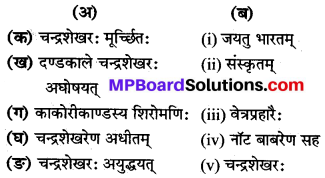
उत्तर:
(क) → (iii)
(ख) → (i)
(ग) → (v)
(घ) → (ii)
(ङ) → (iv)
Mp Board Class 8th Sanskrit Solution प्रश्न 4.
नामोल्लेखपूर्वकं समास-विग्रहं कुरुत(नाम का उल्लेख करते हुए समास विग्रह करो-)
(क) संस्कृतविद्यालये
(ख) पाषाणखण्डेन
(ग) निग्रहभयात्
(घ) वीरगतिम्।
उत्तर:
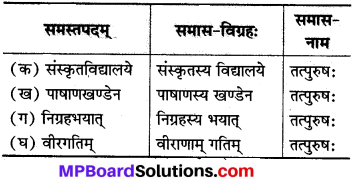
Class 8th Sanskrit Mp Board प्रश्न 5.
अधोलिखितैः अव्ययैः वाक्यनिर्माणं कुरुत(नीचे लिखे अव्ययों से वाक्यों का निर्माण करो-)
(क) कदा
(ख) च
(ग) एव
(घ) अपि
(ङ) श्वः।
उत्तर:
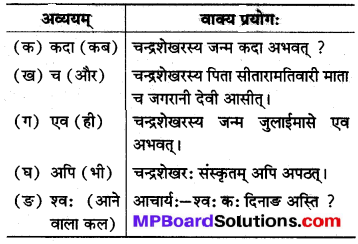
आजादचन्द्रशेखरः हिन्दी अनुवाद
(आचार्यः :
कक्षायाम् शिक्षयति) आचार्य:-भो रमे! श्वः कः दिनाङ्क अस्ति?
रमा :
श्वः जुलाईमासस्य त्रयोविंशति-दिनाङ्क अस्ति।
आचार्य :
जुलाईमासस्य त्रयोविंशति-दिनाङ्क किमर्थं प्रसिद्ध?
प्रिया :
अस्मिन्नेव दिनाङ्के आजादचन्द्रशेखरस्य जयन्त्याः उत्सवः आयोज्यते।
आचार्य: :
चन्द्रशेखरस्य जन्म कस्मिन् ख्रिस्ताब्दे अभवत्?
विभुः :
चन्द्रशेखरस्य जन्म १९०६ ख्रिस्ताब्दे अभवत्।
आचार्य: :
सम्यगुक्तं भवता।
अनुवाद :
(आचार्य कक्षा में पढ़ा रहे हैं)
आचार्य :
अरे रमा! कल कौनसी तारीख है?
रमा :
कल जुलाई महीने की 23 तारीख है।
आचार्य :
जुलाई महीने की 23 तारीख किसलिए प्रसिद्ध हैं?
प्रिया :
इसी तारीख को आजाद चन्द्रशेखर की जयन्ती का उत्सव आयोजित किया जाता है।
आचार्य :
चन्द्रशेखर का जन्म किस ईस्वी सन् में हुआ था?
विभु :
चन्द्रशेखर का जन्म 1906 ईस्वी सन् में हुआ था।
आचार्य :
ठीक कहा आपने। रमा-भो आचार्य! चन्द्रशेखरस्य जन्म कुत्र अभवत्?
आचार्य: :
चन्द्रशेखरस्य जन्म मध्यप्रदेशे झाबुआम्ण्डलान्तर्गते ‘भाभरा’ नामकग्रामे अभवत्।
प्रिया :
भो आचार्य! कौ तस्य पितरौ?
आचार्यः :
सीतारामतिवारी तस्य पिता, जगरानीदेवी च तस्य माता आसीत्।
विभुः :
तस्य अध्ययनं कुत्र अभवत्?
आचर्यः :
वाराणस्याम् एकस्मिन् संस्कृतविद्यालये तस्य अध्ययनं जातम्। सः संस्कृतम् अधीतवान्।
(साश्चर्यम् सर्वे अहो! एषः संस्कृतम् अधीतवान्।)
पीयूषः :
ततः सः किमकरोत्?
आचार्यः :
वाराणस्यां संस्कृतविद्यालये अध्ययनं में कुर्वन् एव पंचदशवर्षीयः चन्द्रशेखरः स्वतन्त्रान्दोलने प्राविशत्। आङग्लैः स्वाधीनतान्दोलनकारिणां दमनकाले सः पाषाणखण्डेन एकं रक्षकम् प्राहरत्।
रमा :
ततः किम् अभवत्?
आचार्यः :
ततः प्रहरी तं निगृह्य न्यायालये प्रस्तुतवान्।
अनुवाद :
रमा-हे आचार्य! चन्द्रशेखर का जन्म कहाँ हुआ था?
आचार्य :
चन्द्रशेखर का जन्म मध्य प्रदेश के झाबुआ। मण्डल के अन्तर्गत ‘भाभरा’ नामक गाँव में हुआ था।
प्रिया :
हे आचार्य! उनके माता-पिता कौन थे?
आचार्य :
सीताराम तिवारी उनके पिता और जगरानी देवी। उनकी माता थीं।
‘विभु :
उनका अध्ययन कहाँ हुआ था?
आचार्य :
वाराणसी में एक संस्कृत विद्यालय में उनका अध्ययन हुआ था। उन्होंने संस्कृत पढ़ी थी।
(आश्चर्य के साथ सभी ओहो! इन्होंने संस्कृत पढ़ी थीं?)
पीयूष :
उसके बाद उन्होंने क्या किया?
आचार्य :
वाराणसी में संस्कृत विद्यालय में अध्ययन करते हुए ही पन्द्रह वर्ष के चन्द्रशेखर स्वतन्त्रता आन्दोलन में प्रवेश कर गये। अंग्रेजों द्वारा स्वाधीनता आन्दोलन करने वालों के दमन (दबाने) के समय उन्होंने पत्थर के टुकड़े से एक सिपाही पर प्रहार किया।
रमा :
उसके बाद क्या हुआ?
आचार्य :
उसके बाद सिपाही ने उनको पकड़कर न्यायालय में प्रस्तुत किया।
प्रिया :
न्यायालये किं जातम्?
आचार्य: :
न्यायालये न्यायाधीशेन तस्य आयुषोगणनानुसारम् पंचदशवेत्रप्रहारैः सः दण्डितः।
विभुः :
दण्डकाले चन्द्रशेखरस्य का प्रतिक्रिया अभवत्?
आचार्यः :
प्रथमं तु चन्द्रशेखरन्यायाधीशयोः संवाद श्रुणुत.
न्यायाधीश: – किं तव नाम?
चन्द्रशेखरः – ‘आजादः’
न्यायाधीश: – किं तव पितुः नाम?
चन्द्रशेखरः – ‘स्वाधीनः’
न्यायाधीश: – कुत्र तव गृहम्?
चन्द्रशेखरः – कारागारः।
अनुवाद :
प्रिया-न्यायालय में क्या हुआ?
आचार्य :
न्यायालय में न्यायाधीश ने उनकी उम्र के हिसाब के अनुसार पन्द्रह बैंत के प्रहारों से उन्हें दण्ड दिया। विभु-दण्ड के समय चन्द्रशेखर की क्या प्रतिक्रिया हुई?
आचार्य :
पहले तो चन्द्रशेखर और न्यायाधीश की बातचीत सुनो
न्यायाधीश – तुम्हारा नाम क्या है?
चन्द्रशेखर – ‘आजाद’
न्यायाधीश – तुम्हारे पिता का नाम क्या है?
चन्द्रशेखर – स्वतन्त्रता।
न्यायाधीश – तुम्हारा घर कहाँ है?
चन्द्रशेखर – जेल।
पीयूषः – ततस्ततः?
आचार्य: :
ततस्तु वेत्रप्रहारैः चन्द्रशेखरः मूर्छापर्यन्तं ‘जयतु भारतम्’ इति उच्चैः अघोषयत्। तस्मात् कालादेव सः ‘आजाद-चन्द्रशेखर’ इति नाम्ना प्रसिद्धः।
रमा :
स्वतन्त्रतायै सः किं कृतवान्?
आचार्य: :
तेन ‘हिन्दुस्तान सोसलिस्ट रिपब्लिकन आर्मी’ इति स्वाधीनतासैनिकानाम् एकं सङ्गठनं कृतम्। तस्मिन् सङ्गठने भगतसिंह-राजगुरु-बटुकेश्वर-शिवराम-सुखदेवसदृशाःक्रान्तिकारिणः तस्यसहायका:अभवन्।काकोरीसाईमनकमीशन-केन्द्रीय-असेम्बलीमध्ये आग्नेयास्त्रप्रक्षेपणादिषुणादिषु सः शिरोमणिः।
अनुवाद :
पीयूष-उसके बाद?
आचार्य :
उसके बाद तो बैंत के प्रहारों से चन्द्रशेखर बेहोश होने तक ‘भारत माता की जय’, ऐसा जोर से कहते रहे। उस समय से ही वह आजाद चन्द्रशेखर’ नाम से प्रसिद्ध हुए।
रमा :
स्वतन्त्रता के लिए उन्होंने क्या किया?
आचार्य :
उन्होंने ‘हिन्दुस्तान सोसलिस्ट रिपब्लिकन आर्मी’ ऐसा स्वाधीनता के सैनिकों का एक संगठन बनाया। उस संगठन में भगतसिंह, राजगुरु, बटुकेश्वर, शिवराम, सुखदेव जैसे क्रान्तिकारी उनके सहायक हुए। काकोरी, साइमन कमीशन, केन्द्रीय असेम्बली के बीच में बम फेंकने आदि में वह सबसे ऊपर थे।
प्रिया :
कः तस्य आदर्शः?
आचार्यः :
देशभक्तिः। अपि च तस्य जनकस्य सहायतार्थं मित्रैः प्रदत्तधनमपि सः क्रान्तिकार्येषु व्ययं कृतवान्। विभुः-कथं कदा च तस्य बलिदानम् अभवत्?
आचार्यः :
फरवरी मासस्य सप्तविंशतितमे दिनाङ्के १९३१ ख्रिस्ताब्दे इलाहाबादनगरे (प्रयाग-नगरे) ‘आजाद-उद्यानम्’ (अल्फ्रेड पाक) इति स्थाने आङ्ग्लगुप्तचरेणाधीक्षकेण नॉट-बाबरेण गोलिकाभिः युद्धयमानः यदा आत्मानम् असहायम् अमन्यत तदा निग्रहभयात् स्वहस्तेनैव स्वकीये मस्तके गोलिका-प्रहारेण सः वीरगतिम् प्राप्नोत्।
अनुवाद :
प्रिया-उनका आदर्श क्या था? का आचार्य-देशभक्ति। और उनके पिता की सहायता के लिए। मित्रों द्वारा दिये धन को भी उन्होंने क्रान्ति के कार्यों में व्यय किया।
विभु :
कैसे और कब उनका बलिदान हुआ?
आचार्य :
फरवरी महीने की सत्ताइस (27) दिनांक को 1931 ईस्वी में इलाहाबाद नगर (प्रयाग नगर) में आजाद उद्यान’ (अल्फ्रेड पार्क) नामक स्थान पर अंग्रेज गुप्तचर अधीक्षक नॉट-बाबर से गोलियों से युद्ध करते हुए जब अपने को असहाय माना तब पकड़े जाने के भय से अपने हाथ से ही अपने सिर में गोली के प्रहार से उन्होंने वीरगति प्राप्त की।
आजादचन्द्रशेखरः शब्दार्थाः
जयन्त्याः = जयन्ती का। सङ्गठनम् = संघ को। ख्रिस्ताब्दे = ईस्वी में। आग्नेयास्त्रम् = बम। सम्यगुक्तम् = ठीक कहा। निग्रहभयात् = पकड़े जाने के भय से। निगृह्य = पकड़कर। वेत्रप्रहारैः = बेंत के प्रहारों से। मूर्छापर्यन्तम् = मूछित होने तक।
